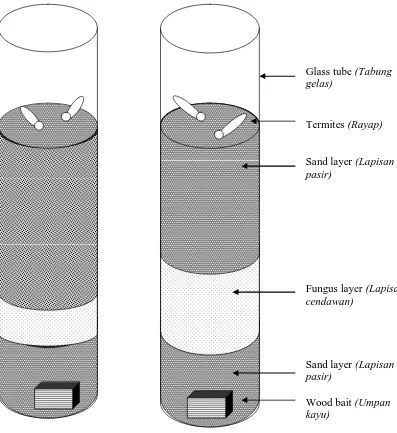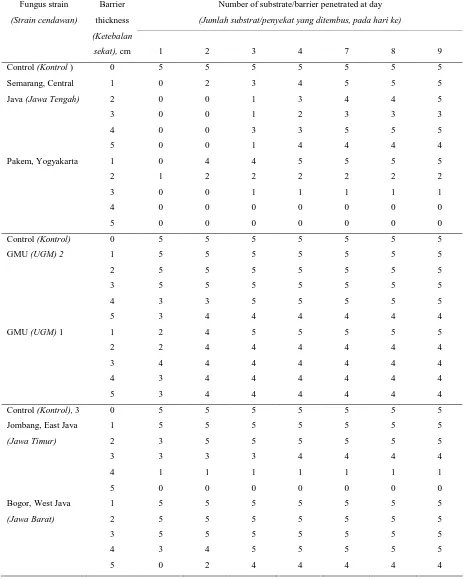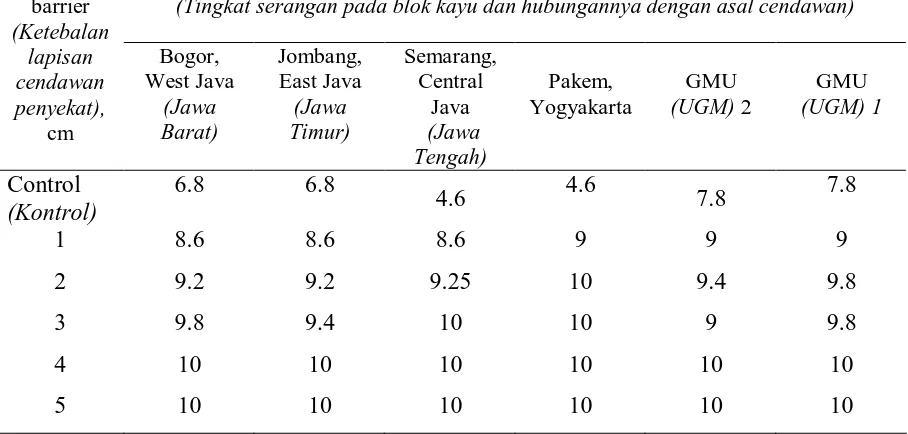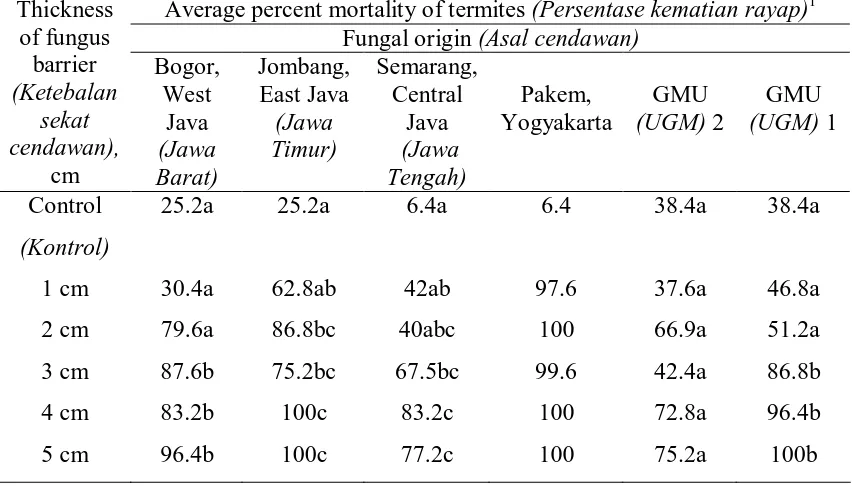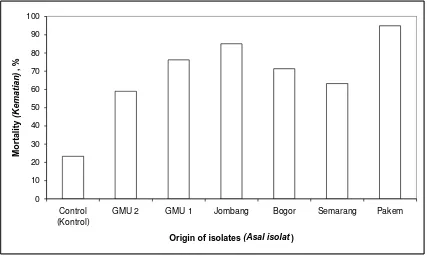A LABORATORY TRIAL ON APPLYING ENTOMOPATHOGENIC FUNGUS Metarhizium anisopliae AS A BARRIER FOR SUBTERRANEAN
TERMITE Coptotermes curvignathus
(Percobaan Laboratoris mengenai Penggunaan Cendawan Patogen Serangga Metarhizium anisopliae sebagai Penyekat
Rayap Tanah Coptotermes curvignathus)
By/Oleh:
Paimin Sukartana, Agus Ismanto, Rusti Rushelia & Neo Endra Lelana
ABSTRACT
Control of subterranean termites relies on chemical insecticides that mostly
environmentally unacceptable. Biological control, for example using
entomopathogenic fungi, is pursued to minimize applying the poisonous chemicals.
This experiment was designated to determine effectiveness of 6 strains of
entomopathogenous fungus Metarhizium anisopliae, obtained from various locations,
as a barrier for subterranean termite C. curvignathus. Various thickness of the fungi
that were cultured in rice media were applied for termite barriers set in glass tubes
together with sand substrate and tusam wood blocks (Pinus merkusii) of 2 x 1 x 1 cm
for bait. 50 termites, containing of 45 workers and 5 soldiers, were introduced into
each tube. The tests were incubated for 9 days at room temperature.
Results showed that most termites were able to reach the wood bait, but only
termites succeeding in penetrating the fungal barriers of 2 cm thickness or less could
feed the bait significantly. Percentage of termite mortality was mostly high at the
treatment with fungal barrier of 4 and 5 cm thickness. Fungus strain obtained from
strains from Jombang (East Java), Gadjah Mada University (GMU) 1, Bogor (West
Java), Semarang (Central Java), and Gadjah Mada University (GMU) 2. Barrier
thicknesses of 4 and 5 cm generally cused high termite mortality ranging from 80 to
100%.
Key words: Fungal barrier, penetration, termite attack and termite mortality
ABSTRAK
Pengendalian rayap selama ini lebih tergantung pada penggunaan insektisida kimia yang pada umumnya tidak ramah lingkungan. Pengendalian secara biologis, misalnya menggunakan cendawan patogen serangga, sedang dikembangkan untuk mengurangi penggunaan bahan-bahan kimia beracun tersebut. Penelitian ini bertujuan untuk menentukan efektivitas 6 strain cendawan patogen serangga,
Metarhizium anisopliae (Metschnikoff) Sorokin, yang diperoleh dari berbagai lokasi,
sebagai penyekat serangan rayap tanah Coptotermes curvignathus. Beberapa tingkat ketebalan cendawan yang dibiakkan dalam media beras digunakan sebagai penyekat yang disusun bersama-sama dengan media pasir dan umpan blok kayu tusam (Pinus
merkusii) dalam tabung reaksi. Rayap tanah sebanyak 50 ekor terdiri dari 45 ekor
rayap pekerja dan 5 ekor rayap perajurit dimasukkan ke dalam masing-masing tabung reaksi, dan kemudian percobaan disimpan pada suhu kamar selama 9 hari.
Jombang (Jawa Timur), Universitas Gadjah Mada (UGM) 1 (Yogyakarta), Bogor (Jawa Barat), Semarang (Jawa Tengah) dan UGM 2 (Yogyakarta). Ketebalan cendawan penyekat 4 sampai dengan 5 cm pada umumnya dapat menyebabkan kematian rayap yang tinggi, antara 80 sampai dengan 100%.
Kata kunci: Cendawan penyekat, penembusan, serangan dan kematian rayap
I. INTRODUCTION
Termites are social insects found in a wide range of terrestrial environments that
are distributed throughout the warmer regions of the world (Becker, 1976). These
insects are the most important structural pest and most destructive among other wood
destroying insects in Indonesia. Coptotermes (Isoptera: Rhinotermitidae) is one of the
most economically important pest termite genus that attack wood and wood based
materials anywhere in the tropic and subtropics. Serious damage on wood structures
and living trees caused by this termite genus is found in Bogor and its around
(Sukartana, 2002). C. curvignathus Holmgren is one of the most important species in
this country.
Control of termites so far relies on applying chemical insecticides that are used
for soil treatment around structures (Su and Scheffrahn, 1990 and Grace et al., 1993).
Using insecticides can however not only contaminate our environment but also cause
pest resistance so controlling the pest will be more difficult. Alternative methods that
are considered environmentally friendlier should be pursued. Biological control as a
termite control technology is becoming more desirable. Some entomopathogenous
fungi have been studied as bioinsecticides for those purposes (Lai et al., 1982; Milner
Some preliminary studies on applying bioinsecticides, especially
entomopathogenic fungus Metharizium anisopliae (Metschnicoff) Sorokin, had been
conducted in Forest Products Research and Development Center, Bogor (Sukartana et
al., 2000; Sukartana and Rushelia, 2000; Setiawan et al., 2000). These studies should
be accelerated to obtain specimen(s) that is(are) cost-effective and environmentally
safe alternatives to chemical control for termite control. The objective of this study
was to determine effectiveness of various strains of M. anisopliae as a barrier for
subterranean termite C. curvignathus in a laboratory trial.
II. MATERIALS AND METHODS
Six strains of entomopathogenic fungus M. anisopliae were used. These fungus
strains were obtained from Research Unit for Biotechnology of Crop Plantation,
Bogor; Department of Plant Pests and Diseases, Faculty of Agriculture, Gadjah Mada
University, Yogyakarta (GMU 1 and 2); Laboratory of Biological Control in Pakem
(Yogyakarta), Semarang (Central Java), and Jombang (East Java). The fungus
isolates were cultured in PDA media and then transferred into rice media according to
the procedures of Jenkins et al. (1998).
Tusam (Pinus merkusii) wood blocks of 2 x 1 x 1 cm were used as termite bait,
and sieved sand using mosquitoes screen wire was used for termite substrate. Each
wood block was put in a glass tube of 1.8 cm diameter and 18 cm height. Sand media
that had been wetted according to Sornuwat et al. (1995) was filled in the tube until 3
cm thickness. Fungus cultured on the rice media was filled with various thickness of
1, 2, 3, 4 and 5 cm above the sand, an on top of the fungus, wetted sand was again
filled until 4 cm bellow the lip of the tube (Figure 1). These preparations were kept
Termite specimens were collected from municipal area neighbouring of the
Centre for Forest Products Research and Development, Bogor. The termites were kept
in laboratory for at least two week for acclimatization. Fifty termites containing of 45
workers and 5 soldiers were introduced into each tube. Each tube was loosely caped
with aluminum foil to avoid substrate desiccation. The experiments were then
[image:5.595.167.564.245.678.2]incubated at a room temperature for 9 days. Five replicates were prepared.
Figure 1. Trial arrangements with two kinds of fungus barrier thickness
Gambar 1. Susunan percobaan dengan dua macam ketebalan cendawan penyekat
Glass tube (Tabung gelas)
Termites (Rayap)
Sand layer (Lapisan pasir)
Fungus layer (Lapisan cendawan)
Sand layer (Lapisan pasir)
Observations were made at interval of 2–3 days to determine the termite
activities that were represented by penetration of the termite through the fungal
barrier. At the end of experiment, numbers of termite mortality were counted, and
rating of termite attack on wood bait was scored according to the standard of ASTM
(Anonymous, 1995). After transformed into arcsine of the square root percentage, the
mortality data were analyzed using ANOVA and then evaluated their treatment
differences according to the procedure of Tukey’s w Procedure (Steel and Torrie,
1980).
III. RESULTS AND DISCUSSION
Table 1 showed that all termites in each tube had tried to reach the wood bait
located in the base of the tube for their food. Several of them failed to reach the bait.
To reach the bait, they had to make tunnel through sand covering the wood bait
(control), or through sand-fungus-sand barriers (treated). All termites in the control
were able to reach the wood bait, and then attacked the bait. Meanwhile, even though
the termites succeeded in penetrating the fungal barrier and reached the bait, they did
not consume the bait significantly, or even leaved the bait intact particularly on the
treatment using fungus barrier thickness of 4 cm or more (Table 2). Therefore, it can
Table 1. Penetration of termite through Metarhizium anisopliae barrier1 Tabel 1. Penembusan rayap melalui penyekat Metarhizium anisopliae1
Number of substrate/barrier penetrated at day
(Jumlah substrat/penyekat yang ditembus, pada hari ke) Fungus strain
(Strain cendawan)
Barrier
thickness
(Ketebalan
sekat), cm 1 2 3 4 7 8 9
Control (Kontrol ) 0 5 5 5 5 5 5 5
Semarang, Central 1 0 2 3 4 5 5 5
Java (Jawa Tengah) 2 0 0 1 3 4 4 5
3 0 0 1 2 3 3 3
4 0 0 3 3 5 5 5
5 0 0 1 4 4 4 4
Pakem, Yogyakarta 1 0 4 4 5 5 5 5
2 1 2 2 2 2 2 2
3 0 0 1 1 1 1 1
4 0 0 0 0 0 0 0
5 0 0 0 0 0 0 0
Control (Kontrol) 0 5 5 5 5 5 5 5
GMU (UGM) 2 1 5 5 5 5 5 5 5
2 5 5 5 5 5 5 5
3 5 5 5 5 5 5 5
4 3 3 5 5 5 5 5
5 3 4 4 4 4 4 4
GMU (UGM) 1 1 2 4 5 5 5 5 5
2 2 4 4 4 4 4 4
3 4 4 4 4 4 4 4
4 3 4 4 4 4 4 4
5 3 4 4 4 4 4 4
Control (Kontrol), 3 0 5 5 5 5 5 5 5
Jombang, East Java 1 5 5 5 5 5 5 5
(Jawa Timur) 2 3 5 5 5 5 5 5
3 3 3 3 4 4 4 4
4 1 1 1 1 1 1 1
5 0 0 0 0 0 0 0
Bogor, West Java 1 5 5 5 5 5 5 5
(Jawa Barat) 2 5 5 5 5 5 5 5
3 5 5 5 5 5 5 5
4 3 4 5 5 5 5 5
5 0 2 4 4 4 4 4
1
masing-masing ketebalan penyekat menunjukkan jumlah penyekat yang ditembus rayap)
Termite mortality was summarized in Table 3. Analysis of variance of the data
indicated that there were significant difference among treatments, but not for the
treatment using fungus barrier obtained from GMU 2. Further analysis using Tukey’s
w Procedure (p < 0.5) showed that percentage of termite mortalities generally
corresponded with penetration of the termite through the fungal barrier (Table 1) and
infestation rate of the wood blocks (Table 2). Thus, most percent mortality of the
termites was significantly affected by thickness of the fungal barrier, except fungal
barrier that was developed from GMU 2 isolate which was least effective.
Figure 2 summarizes the entire resultas.Based on height of the columns, it was
shown that fungus strain from Pakem (Yogyakarta) was the most promising and was
then, in descendent order, followed by strains originally from Jombang (East Java),
GMU 1, Bogor, Semarang and GMU 2. This figure again confirmed with those
statistical analysis concerning the less effectiveness of the fungus strain from GMU 2.
Milner (2000) stated that fungus strains affected to tunneling ability and
mortality of subterranean termite C. lacteus. In his studies, most fungi strains obtained
from termites caused higher termite mortality than that from other insects. After 14-18
days experimentation, most termites introduced to that fungi strains had died. Long
time culturing of the fungi in artificial media might reduce the fungi virulence.
However, re-isolate the fungus through its host or related insect could increase the
Table 2. Means of infestation rate of termite attack on wood block1 Tabel 2. Rata-rata tingkat serangan rayap pada blok kayu1
Infestation rate of wood blocks in connection with fungus origin (Tingkat serangan pada blok kayu dan hubungannya dengan asal cendawan) Thickness of fungus barrier (Ketebalan lapisan cendawan penyekat), cm Bogor, West Java (Jawa Barat) Jombang, East Java (Jawa Timur) Semarang, Central Java (Jawa Tengah) Pakem, Yogyakarta GMU (UGM) 2 GMU (UGM) 1 Control (Kontrol)
6.8 6.8
4.6 4.6 7.8 7.8
1 8.6 8.6 8.6 9 9 9
2 9.2 9.2 9.25 10 9.4 9.8
3 9.8 9.4 10 10 9 9.8
4 10 10 10 10 10 10
5 10 10 10 10 10 10
1
Remarks (Keterangan): Infestation rate was scored according to ASTM Standard
(ASTM, 1995) (Tingkat serangan dinilai menurut Standard
ASTM, 1995)
Termite mortality is caused by penetrating of the fungus pathogen into the
body of the termites (Yendol and Paschke, 1965). It seemed, when the termites
tunneled the fungus barrier for searching food in the tube base, the fungus infected the
termites and consequently caused termites death. A laboratory bioassay showed that
fungi M. anisopliae and Verticilium indicum might cause high mortality to dry-wood
termite Cryptotermes brevis (Nasr and Moein, 1997). M. anisopliae produces spores
which kill termites by penetrating the body surface and multiplying throughout the
Table 3. Average percent mortality of the termites introduced to 6 strains of fungus barrier
Tabel 3. Rata-rata persentase kematian rayap yang dicoba terhadap 6 strain cendawan
Average percent mortality of termites (Persentase kematian rayap)1 Fungal origin (Asal cendawan)
Thickness of fungus barrier (Ketebalan sekat cendawan), cm Bogor, West Java (Jawa Barat) Jombang, East Java (Jawa Timur) Semarang, Central Java (Jawa Tengah) Pakem, Yogyakarta GMU (UGM) 2 GMU (UGM) 1 Control (Kontrol)
25.2a 25.2a 6.4a 6.4 38.4a 38.4a
1 cm 30.4a 62.8ab 42ab 97.6 37.6a 46.8a
2 cm 79.6a 86.8bc 40abc 100 66.9a 51.2a
3 cm 87.6b 75.2bc 67.5bc 99.6 42.4a 86.8b
4 cm 83.2b 100c 83.2c 100 72.8a 96.4b
5 cm 96.4b 100c 77.2c 100 75.2a 100b
1
Remarks (Keterangan): Numbers in each column followed by same letter not
significantly different, Tukey test, P < 0.05 (Angka-angka
pada masing-masing kolom yang diikuti dengan huruf yang sama tidak berbeda nyata menurut uji Tukey, P < 0,05)
Entomopathogenic fungi produce chitinolytic, lipolytic and proteolytic
enzymes that are able to biochemically degrade an insect body (Gabriel, 1968; Leger
et al., 1998). Because of their abilities, some insect pathogens are potentially useful
for termite control (Grace and Zoberi, 1992, Nasr and Noein, 1997). These laboratory
trials also confirmed the similar phenomena about possibility of developing the
[image:10.595.89.515.185.428.2]0 10 20 30 40 50 60 70 80 90 100
Control (Kontrol)
GMU 2 GMU 1 Jombang Bogor Semarang Pakem
Origin of isolates (Asal isolat )
Morta
lit
y
(Kemati
an
)
, %
Figure 2. Summarizing of average termite mortality percentage of termite mortality caused by the barriers of the 6 strains of entomopathogenic fungus
Gambar 2. Ringkasan persentase kematian rayap karena perlakuan penyekat 6 strain cendawan patogen serangga
IV. CONCLUSION
It can be concluded that a strain of entomopathogenic fungus, M. anisopliae,
from Pakem (Yogyakarta) was the most promising for termite barrier than those from
others. Fungus barrier that was developed from Pakem isolate of 2 cm thickness or
more could cause 100 % termite mortality after 9 days experimentation. The fungus
strain from Jombang was less effective. Barrier effectiveness from this fungus can be
achieved at the fungus barrier thickness of 4 cm or more. The remains were
[image:11.595.97.524.75.335.2]Semarang (Central Java) and GMU 2. Improving fungus effectiveness will be carried
out, particularly for the promising fungus strains.
Acknowledgments
The authors wish to thank Ir. Trihardjoko, M.Sc. Lecturer of the Department of
Plant Pests and Diseases, Faculty of Agriculture, Gadjah Mada University (GMU),
Yogyakarta, and Dr. Darmono Taniwiryono, Principal Researcher of the
Biotechnology Research Unit for Crop Plantation, Bogor, for their kindly contribution
of giving us respectively isolates of GMU 1 and 2, and an isolate of Bogor.
REFERENCES
Anonymous. 1995. American Standard for Testing and Materials (ASTM, D
3345-74): Standard method of laboratory evaluation of wood and other
cellulosic materials for resistance to termites. Annual Book of ASTM
Standard. Vol. 04.09(Wood): 430-432.
Becker, G. 1976. Concerning termites and wood. Unasylva, an International Journal
of Forestry and Forest Industries: 28(3): 2-11.
Gabriel, B. P. 1968. Enzymatic activities of some entomophthorous fungi. J. Invert.
Pathol. 11: 70-81.
Grace, J. K. and M. H. Zoberi. 1992. Experimental evidence of transmission of
Beauveria bassiana by Reticulitermes flavipes workers (Isoptera:
Rhinotermitidae). Sociobiology. 20(1): 23-28.
Grace, J. K., J. R. Yates, M. Tamashiro and R. T. Yamamoto. 1993. Persistence of
organochloririne insecticides for Formosan subterranean termite (Isoptera:
Jenkins, N. E., G. Heviefo, J. Langewald, A. J. Chery and C. J. Loomer. 1998.
Development of mass production technology for aerial conidia for use as
mycopesticides. Biocontrol, News and Information, 19(1): 21N-31N.
Lai, P. Y., M. Tamashiro and J. K. Fujii. 1982. Pathogenicity of six strains of
entomogenous fungi to Coptotermes formosanus. J. Invert. Pathol. 39: 1-5
Leger, R. J. St., L. Joshi and D. Roberts. 1998. Ambient pH is a major determinant in
the exppression of cuticle-degrading enzymes and hydrophobin by
Metarhizium anisopliae. Appl. Environ. Microbiol. 64(2): 709-713.
Milner, R. J. 2000. Improved formulations of Metarizhium for biological control of
termites. Tech. Report No. 86, CSIRO, Melbourne.
Milner, R. J. and J. A. Staples. 1996. Biological control of termites: results and
experiences within a CSIRO Project in Australia. Biocontrol Sci. Technol.
6: 3-9.
Milner, R. J., J. A. Staples and G. G. Lutton. 1997. The selection of an isolate of the
hyphomycete fungus, Metarhizium anisopliae, for control of termites in
Australia. Biol. Control. 11: 240-247.
Nasr, F. N. and S. I. M. Moein. 1997. New trend of the use of Metarhizium anisopliae
and Verticillium indicum as entomopathogens to the termite Cryptotermes
brevis. Anz. Schädlingskde., Pflanzenschutz., Umweltschutz. 70: 13-16. Setiawan, I., P. Sukartana dan I. Sumardi. 2000. Efektivitas cendawan dan bakteri
entomopatogen untuk pencegahan rayap tanah Coptotermes curvignathus
Holmgren (Isoptera: Rhinotermitidae). Prosid. Seminar Nasional MAPEKI
III, Bandung, 22-23 Agust. 2000: 470-476.
Sornuwat, Y., C. Vongkaluang, T. Yoshimura, K. Tsunoda and M. Takahashi. 1995.
gestroi Wasmann using the Japanese Standardized testing method and the
modified wood block test in bottle. Wood Res. No. 82: 8-13.
Steel, R. G. D. and J. H. Torrie. 1980. Principles and Procedures of Statistics, A
Biometrical Approach (2nd Edition). McGraw-Hill Book Company, New
York. Pp: 185-186.
Su, N.-Y. and R. H. Scheffrahn. 1990. Comparison of eleven soil termiticides against
the Formosan subterranean termite and Eastern subterranean termite. J.
Econ. Entomol. 83: 1918-1924.
Sukartana, P. 2002. Some evidences of damage caused by subterranean termites
Coptotedrmes spp. on buildings and trees in Bogor and its around.
Proceed. 4th Int. Wood Sci. Symp. LIPI-JSPS Core University Program,
Serpong, Indonesia: 150-155.
Sukartana, P. dan R. Rushelia. 2000. Percobaan pendahuluan: perlakuan tanah dengan
cendawan entomopatogen Metarhizium anisopliae untuk pencegahan
serangan rayap tanah pada kayu. Prosid. Seminar Nasional MAPEKI III,
Bandung, 22-23 Agust. 2000: 461-464.
Sukartana, P., A. Ismanto, W. Rumini and G. Sumarni. 2000. Susceptibility of three
termite species to attack by entomopathogenic fungus Metarhizium
anisopliae. For. Estate Crops Res. J. Bogor. 1(2): 45-49.
Yendol, W. G. and J. D. Paschke. 1965. Pathology of an entomophthora infection in
the eastern subterranean termite Reticulitermes flavipes. J. Invert. Pathol.
